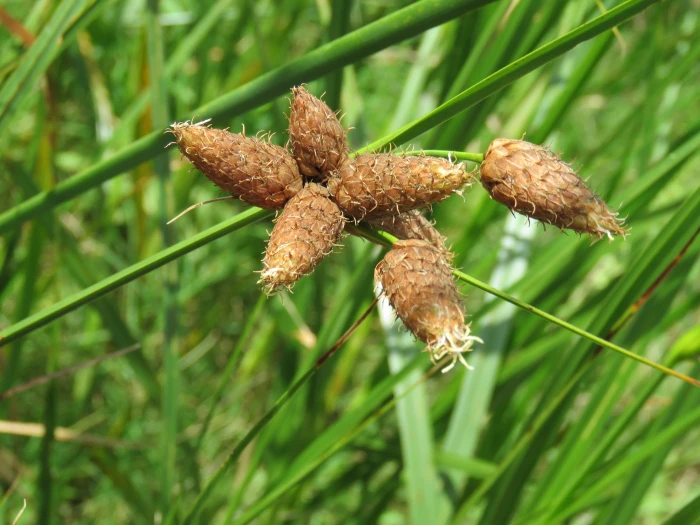Seacoast Bulrush
(Bolboschoenus robustus)
Seacoast Bulrush (Bolboschoenus robustus)
/
/

Laura Clark
CC BY 4.0
Image By:
Laura Clark
Recorded By:
Copyright:
CC BY 4.0
Copyright Notice:
Photo by: Laura Clark | License Type: CC BY 4.0 | License URL: http://creativecommons.org/licenses/by/4.0/ | Rights Holder: Laura Clark | Publisher: iNaturalist | Date Created: 2017-04-14T17:35Z |



















Estimated Native Range
Climate Requirements for Meriden, Connecticut
| This Plant | Your Site | Plant Suitability for Your Location | ||
|---|---|---|---|---|
| • Precipitation | 52" - 63" | 47" | Aquatic | Aquatic |
| • High Temp. | 79°F - 92°F | 85°F | Your summer temperatures are normal for this plant. | Excellent |
| • Low Temp. | 21°F - 50°F | 19°F | Your winter temperatures are normal for this plant | Excellent |
This plant should grow well at your location with about N inches per year (Y minutes per month) of irrigation.
Summary
Bolboschoenus robustus, commonly known as Seacoast Bulrush, is a semi-deciduous perennial grass that thrives in freshwater and brackish marshes, wet meadows, and along the margins of ponds and streams. Its native range extends through the Southeastern United States, California, parts of Mexico, South America, and the Caribbean. This species typically reaches a height of 4-5 feet (1.2-1.5 meters) with a width of 3 feet (0.9 meters). The plant features stiff, upright stems and inflorescences that consist of clustered spikelets, which are brownish-green and not particularly showy. It flowers in the summer months and can produce a significant amount of seeds, which are important food sources for wildlife.
Seacoast Bulrush is valued for its ability to stabilize soil and filter water, making it an excellent choice for riparian restoration projects and naturalized water gardens. It is also used in constructed wetlands for wastewater treatment. In cultivation, it requires full sun to part shade, consistent moisture, and can tolerate standing water, making it suitable for pond edges and water features. While it prefers soils with slow drainage, it is adaptable to various soil types as long as they remain wet. Gardeners should be aware that in ideal conditions, it can spread aggressively through rhizomes and self-seeding, potentially becoming invasive outside its native range.CC BY-SA 4.0
Seacoast Bulrush is valued for its ability to stabilize soil and filter water, making it an excellent choice for riparian restoration projects and naturalized water gardens. It is also used in constructed wetlands for wastewater treatment. In cultivation, it requires full sun to part shade, consistent moisture, and can tolerate standing water, making it suitable for pond edges and water features. While it prefers soils with slow drainage, it is adaptable to various soil types as long as they remain wet. Gardeners should be aware that in ideal conditions, it can spread aggressively through rhizomes and self-seeding, potentially becoming invasive outside its native range.CC BY-SA 4.0
Plant Description
- Plant Type: Grass
- Height: 3.5-4.5 feet
- Width: 2-3 feet
- Growth Rate: Moderate
- Flower Color: N/A
- Flowering Season: Spring, Summer, Fall
- Leaf Retention: Semi-Deciduous
Growth Requirements
- Sun: Full Sun
- Water: High
- Drainage: Slow
Common Uses
Low Maintenance, Water Garden
Natural Habitat
Freshwater and brackish marshes, wet meadows, and along the margins of ponds and streams
Other Names
Common Names: Saltmarsh Bulrush, Sturdy Bulrush, Alkali Bulrush, Stout Bulrush, Three-Cornered Sedge, Leafy Three-Cornered Sedge, Seaside Club-Rush, Scirpe Robuste
Scientific Names: Bolboschoenus robustus, Schoenoplectus robustus, Scirpus robustus, Scirpus maritimus var. macrostachyus, Scirpus robustus var. compactus, Scirpus robustus f. protrusus, Bolboschoenus robustus var. capitatus, Scirpus macrostachyus, Scirpus maritimus var. robustus
GBIF Accepted Name: Bolboschoenus robustus (Pursh) Soják